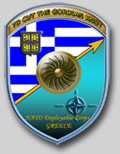The Smyrna Division (Greek : Μεραρχία Σμύρνης) was an infantry division of the Hellenic Army, active in 1919–1920 during the Asia Minor Campaign.

Greek is an independent branch of the Indo-European family of languages, native to Greece, Cyprus and other parts of the Eastern Mediterranean and the Black Sea. It has the longest documented history of any living Indo-European language, spanning more than 3000 years of written records. Its writing system has been the Greek alphabet for the major part of its history; other systems, such as Linear B and the Cypriot syllabary, were used previously. The alphabet arose from the Phoenician script and was in turn the basis of the Latin, Cyrillic, Armenian, Coptic, Gothic, and many other writing systems.

The Hellenic Army, formed in 1828, is the land force of Greece. Along with the Hellenic Air Force (HAF) and the Hellenic Navy (HN), it makes up the Hellenic Armed Forces. It is currently the largest branch of the three. The army is headed by the chief of the Hellenic Army General Staff (HAGS), which in turn is under the command of Hellenic National Defence General Staff (HNDGS).
Following the Greek landing at Smyrna on 2 May 1919, [1] and the establishment of an occupation zone in Ionia, the Smyrna Division began formation on 17 June 1919. Its core was provided by the 8th Cretan Regiment and the newly raised 27th Infantry Regiment, formed from the 1st and 2nd Security Battalions of Thessaloniki. The division's third regiment, the 28th Infantry Regiment, was being formed in Thessaloniki, and arrived at Smyrna on 7 July, along with the divisional artillery and support services. The first commander was Colonel Alexandros Mazarakis-Ainian.

The Greek landing at Smyrna was a military operation by Greek forces starting on May 15, 1919 which involved landing troops in the city of Smyrna and surrounding areas. The Allied powers sanctioned and oversaw the planning of the operation and assisted by directing their forces to take over some key locations and moving warships to the Smyrna harbor. During the landing, a shot was fired on the Greek 1/38 Evzone Regiment and significant violence ensued with Greek troops and Greek citizens of Smyrna participating. The event became important for creating the three-year-long Greek Occupation of Smyrna and was a major spark for the Greco-Turkish War (1919–1922).

Ionia was an ancient region on the central part of the western coast of Anatolia in present-day Turkey, the region nearest İzmir, which was historically Smyrna. It consisted of the northernmost territories of the Ionian League of Greek settlements. Never a unified state, it was named after the Ionian tribe who, in the Archaic Period, settled mainly the shores and islands of the Aegean Sea. Ionian states were identified by tradition and by their use of Eastern Greek.

Thessaloniki, also familiarly known as Thessalonica, Salonica or Salonika, is the second-largest city in Greece, with over 1 million inhabitants in its metropolitan area, and the capital of Greek Macedonia, the administrative region of Central Macedonia and the Decentralized Administration of Macedonia and Thrace. Its nickname is η Συμπρωτεύουσα (Symprotévousa), literally "the co-capital", a reference to its historical status as the Συμβασιλεύουσα (Symvasilévousa) or "co-reigning" city of the Eastern Roman (Byzantine) Empire, alongside Constantinople.
In November 1919, the 8th Cretan Regiment was replaced by the newly raised 30th Infantry Regiment. At about the same time, the Smyrna Division became part of the newly formed Smyrna Army Corps under Lt. General Dimitrios Ioannou, subordinate to the Army of Asia Minor. In 1920, the division participated in the Greek summer offensive, captured Balıkesir and took part in the advance towards Bursa. From there the division were recalled to be used in a landing operation in support of the occupation of Eastern Thrace: the division was ferried from Asia and landed at Ereğli and Rodosto, and thence advanced north. After overcoming Turkish resistance at Lule Burgas, Babaeski and Çorlu and capturing the local Turkish commander, Cafer Tayyar, the division reached Adrianople. Returning to Asia, the Smyrna Division occupied positions around Bursa, and launched a series of raids against Turkish territory.

Dimitrios Ioannou was a senior Greek Army officer who fought in the Macedonian Front during World War I and in the opening stages of the Greco-Turkish War of 1919–1922.
The Army of Asia Minor was the field army-level command controlling the Greek forces in Asia Minor (Anatolia) during the Greco-Turkish War of 1919–1922.

The Greek Summer Offensive of 1920 was an offensive by the Greek army, assisted by British forces, to capture the southern region of the Sea of Marmara and the Aegean Region from the Kuva-yi Milliye of the provisional Turkish national movement government in Ankara. Additionally, the Greek and British forces were supported by the Kuva-yi Inzibatiye of the Ottoman government in Constantinople, which sought to crush the Turkish nationalist forces. The offensive was part of the Greco-Turkish War and was one of several engagements where British troops assisted the advancing Greek army. British troops actively took part in invading coastal towns of the Sea of Marmara. With the approval of the Allies, the Greeks started their offensive on 22 June 1920 and crossed the 'Milne Line'. The 'Milne Line' was the demarcation line between Greece and Turkey, laid down in Paris. Resistance by the Turks was limited, as they had few and ill-equipped troops in western Anatolia. They were also busy on the eastern and southern fronts. After offering some opposition, they retreated to Eskişehir on Mustafa Kemal Pasha's order.
Following the Venizelist defeat in the November 1920 elections, the division lost its commander, Mazarakis, who resigned. Shortly after, it was renamed to 10th Infantry Division by the new royalist government.











